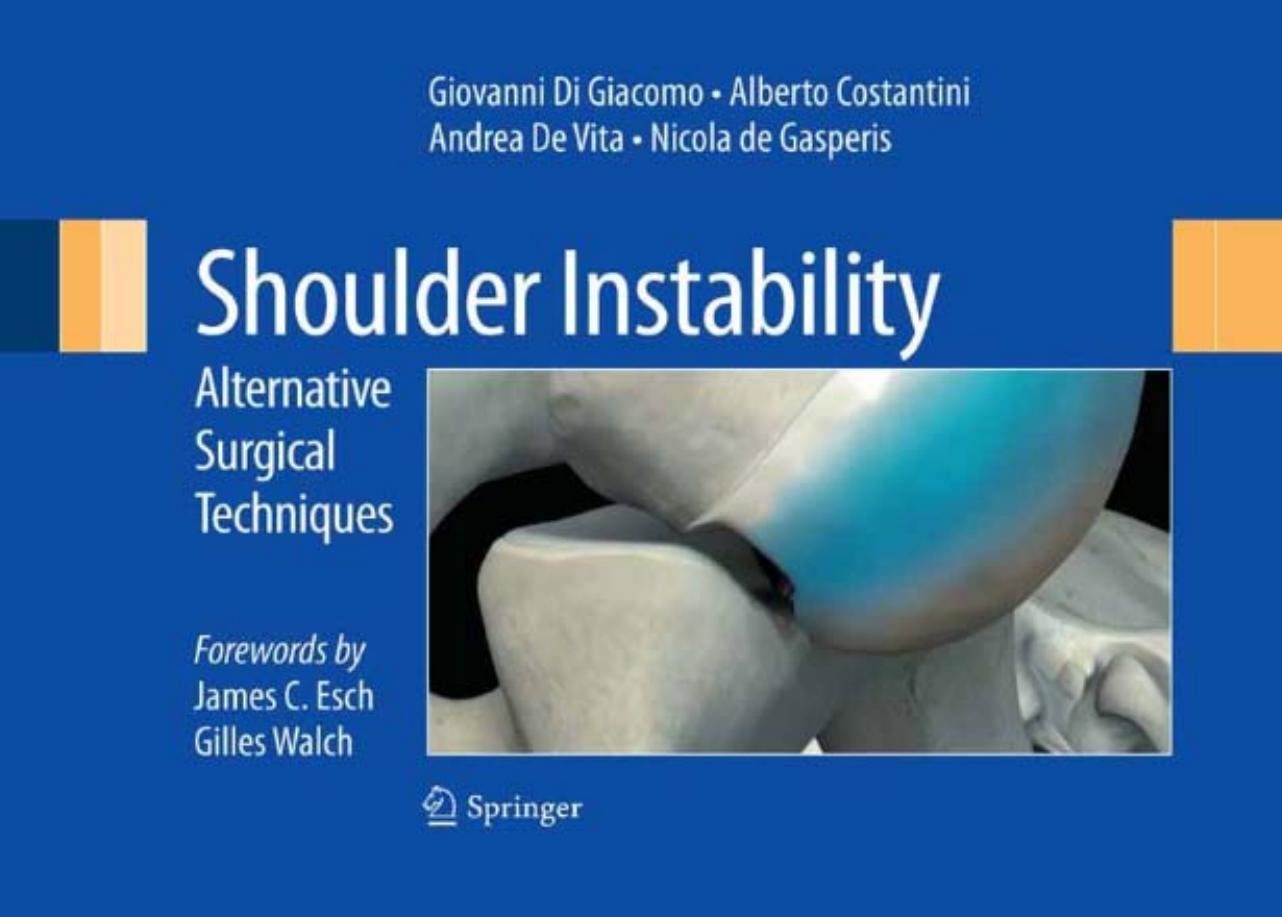Shoulder Instability Alternative Surgical Techniques 1st edition by Giovanni,Alberto,Andrea 9788847020344 8847020344
$70.00 Original price was: $70.00.$35.00Current price is: $35.00.
Instant download Shoulder Instability Alternative Surgical Techniques after payment
Shoulder Instability Alternative Surgical Techniques 1st edition by Giovanni,Alberto,Andrea – Ebook PDF Instant Download/Delivery:9788847020344,8847020344
Full dowload Shoulder Instability Alternative Surgical Techniques 1st edition after payment

Product details:
ISBN 10:8847020344
ISBN 13:9788847020344
Author: Giovanni,Alberto,Andrea
Over the past few years, international literature has highlighted the limitations of arthroscopic treatment for antero-inferior instability of the shoulder. Therefore, the question arises as to which technique – open surgery or arthroscopy – may represent the best alternative to the classical arthroscopic capsuloplasty. The volume is organized into five chapters and presents five different techniques. Each chapter describes the non-surgical and surgical algorithms for the treatment of unidirectional and multidirectional antero-inferior instabilities, with and without shoulder laxity. The chapters offer a detailed description of each technique, enhanced by 10–15 high-definition photographs, tips and tricks, and pitfalls, as well as surgical steps. The book is aimed at medical students, fellows, specialists , orthopedic surgeons, physiotherapists, and rehabilitation and generalist physicians.
Shoulder Instability Alternative Surgical Techniques 1st Table of contents:
CHAPTER 1 – GLENOID TRACK
1.1 Classification of Shoulder Instability
1.2 Algorithm of Treatment
1.3 Hill-Sachs Lesion
1.4 Surgical Indication for Hill-Sachs Lesion
1.5. Glenoid Track
1.5.1 A New Concept
1.5.2 Glenoid Track in Cadaveric Shoulders
1.5.3 Glenoid Track in Live Shoulders
1.5.4 Clinical Application
1.6 Surgical Procedures for Hill-Sachs Lesion
References
CHAPTER 2 – SHOULDER INSTABILITY: GLENOID AND HUMERAL-HEAD BONE DEFECT
2.1 Introduction
2.2 Glenoid-bone Defect
2.2.1 CT Examination Technique
2.3 Humeral Bone Loss
2.4 Conclusion
References
CHAPTER 3 – LATARJET PROCEDURE: THE MINIPLATE SURGICAL TECHNIQUE
3.1 Introduction
3.2 Patient Selection
3.3 Imaging
3.4 Surgery
3.4.1 Exposure Technique
3.4.2 Coracoid Osteotomy
3.4.3 Coracoid Preparation
3.4.4 Coracoid Preparation
3.4.5 Coracoid Preparation
3.4.6 Splitting the Subscapularis Tendon
3.4.7 Capsulotomy
3.4.8 Glenoid Preparation
3.4.9 Glenoid Preparation
3.4.10 Glenoid Preparation
3.4.11 Miniplate (Wedged Profile Plate)
3.4.11.1 Plate Technique
3.4.11.2 Plate Technique
3.4.12 Final Result
References
CHAPTER 4 – DOUBLE-ROW CAPSULOLABRAL REPAIR
4.1 Introduction
4.2 Preoperative Evaluation
4.3 Treatment Algorithm
4.4 Surgical Technique
4.5 Postoperative Rehabilitation
4.6 Conclusion
References
CHAPTER 5 – THE J-BONE GRAFT FOR ANATOMICAL RECONSTRUCTION OF GLENOID DEFECTS
5.1 Introduction
5.1.1 Classification of Instabilities
5.2 General Indications for Treating Shoulder Instability with Conservative and Surgical Techniques
5.3 Algorithm and Indications for Determining Surgery Type and Timing
5.4 Indications for the Authors’ Technique
5.5 Contraindications
5.6 Surgical Technique
5.6.1 Preoperative Workup
5.6.2 Superficial Preparation
5.6.3 Subscapularis Incision
5.6.4 Glenoid Presentation
5.6.5 Harvesting the Graft
5.6.6 J-bone-graft Modelling
5.6.7 Glenoid Osteotomy
5.6.8 Graft Positioning
5.6.9 Closing the Wound
5.7 Postoperative Care
References
CHAPTER 6 – ILIAC-CREST GRAFT AND DISTAL TIBIA ALLOGRAFT PROCEDURE
6.1 Introduction
6.2 History
6.3 Examination
6.4 Imaging
6.5 Management and Surgical Decision Making
6.6 Iliac-crest Graft Technique
6.6.1 Surgical Procedure
6.6.1.1 Patient Positioning
6.6.1.2 Incision and Approach
6.6.1.3 Subscapularis Management
6.6.1.4 Glenoid Preparation
6.6.1.5 Iliac-crest Graft
6.6.1.6 Iliac-crest Graft Placement and Closure
6.7 Distal Tibia Allograft Technique
6.7.1 Surgical Procedure
6.7.1.1 Patient Positioning
6.7.1.2 Incision and Approach
6.7.1.3 Anterior Glenoid Preparation
6.7.1.4 Distal Tibia Allograft Preparation
6.7.1.5 Distal Tibia Allograft Placement and Closure
References
CHAPTER 7 – TREATING RECURRENT ANTERIOR GLENOHUMERAL INSTABILITY USING AN AUTOGENOUS TRICORTICAL I
7.1 Introduction
7.2 Surgical Technique
7.2.1 Patient Positioning
7.2.2 Deltopectoral Approach: Incision
7.2.3 Deltopectoral Approach: Interval Opening
7.2.4 Subscapularis Tendon Split
7.2.5 Capsulotomy
7.2.6 Exposing the Glenoid (1)
7.2.7 Exposing the Glenoid (2)
7.2.8 Glenoid Defect Measurement
7.2.9 Autologous Anterior Iliac-crest Bone Graft: Incision
7.2.10 Anterior Iliac-crest Bone Graft Harvest
7.2.11 Placement and Fixation of the Anterior Iliac-crest Bone Graft
7.2.12 Remodeling the Anterior Iliac-crest Bone Graft
7.2.13 Capsule Repair and Closure
7.3 Postoperative Treatment
7.4 Critical Concepts
7.4.1 Indications
7.4.2 Contraindications
7.4.3 Pitfalls
7.4.4 Authors’ Update
References
CHAPTER 8 – FOCAL RESURFACING OF HUMERAL-HEAD DEFECTS
8.1 Introduction
8.2 Indication/Algorithm
8.3 Technique: Humeral-head Resurfacing with Artificial Implant
8.4 Technique: Humeral-head Allograft
8.5 Postoperative Rehabilitation
8.6 Complications
8.7 Clinical Results
References
People also search for Shoulder Instability Alternative Surgical Techniques 1st:
shoulder instability surgery types
anterior shoulder instability management indications techniques and outcomes
shoulder instability surgery recovery
shoulder instability surgery
shoulder instability surgery protocol


